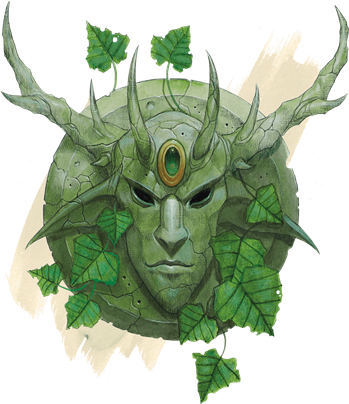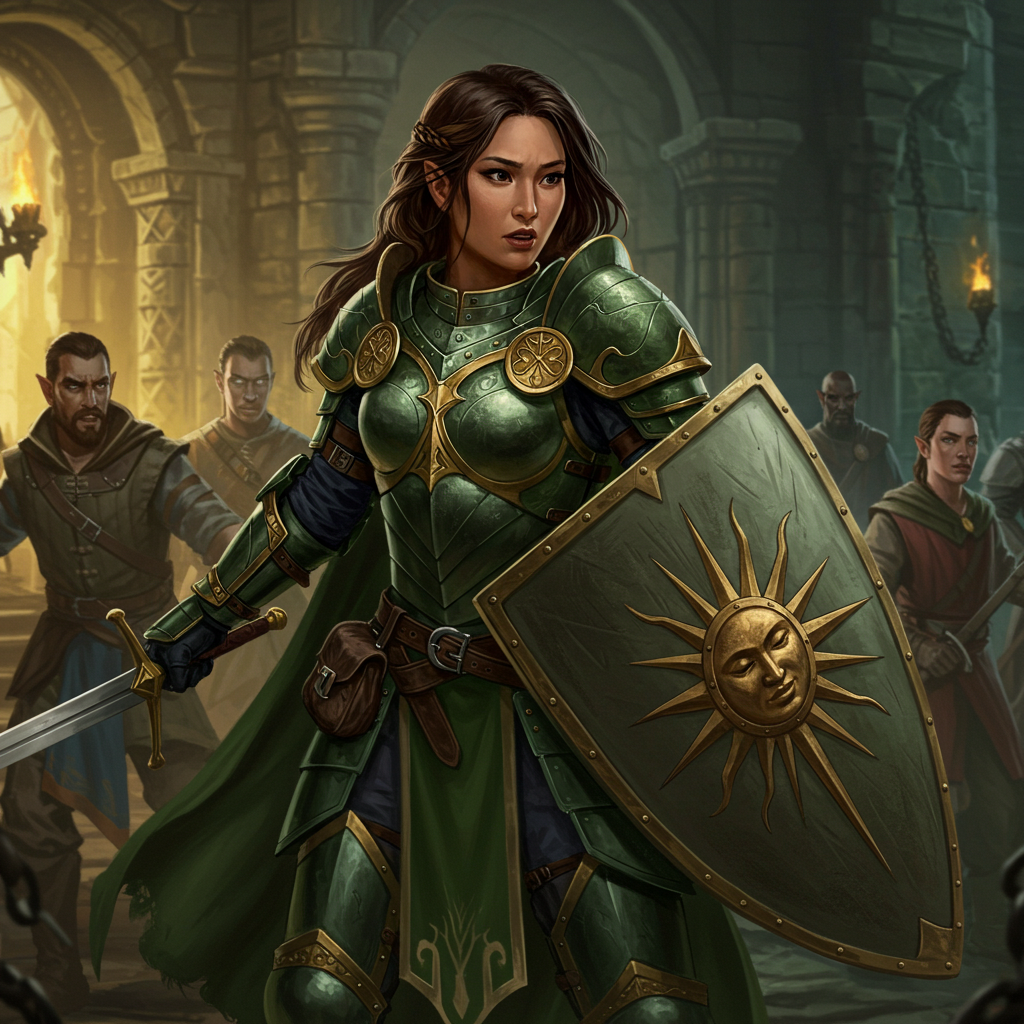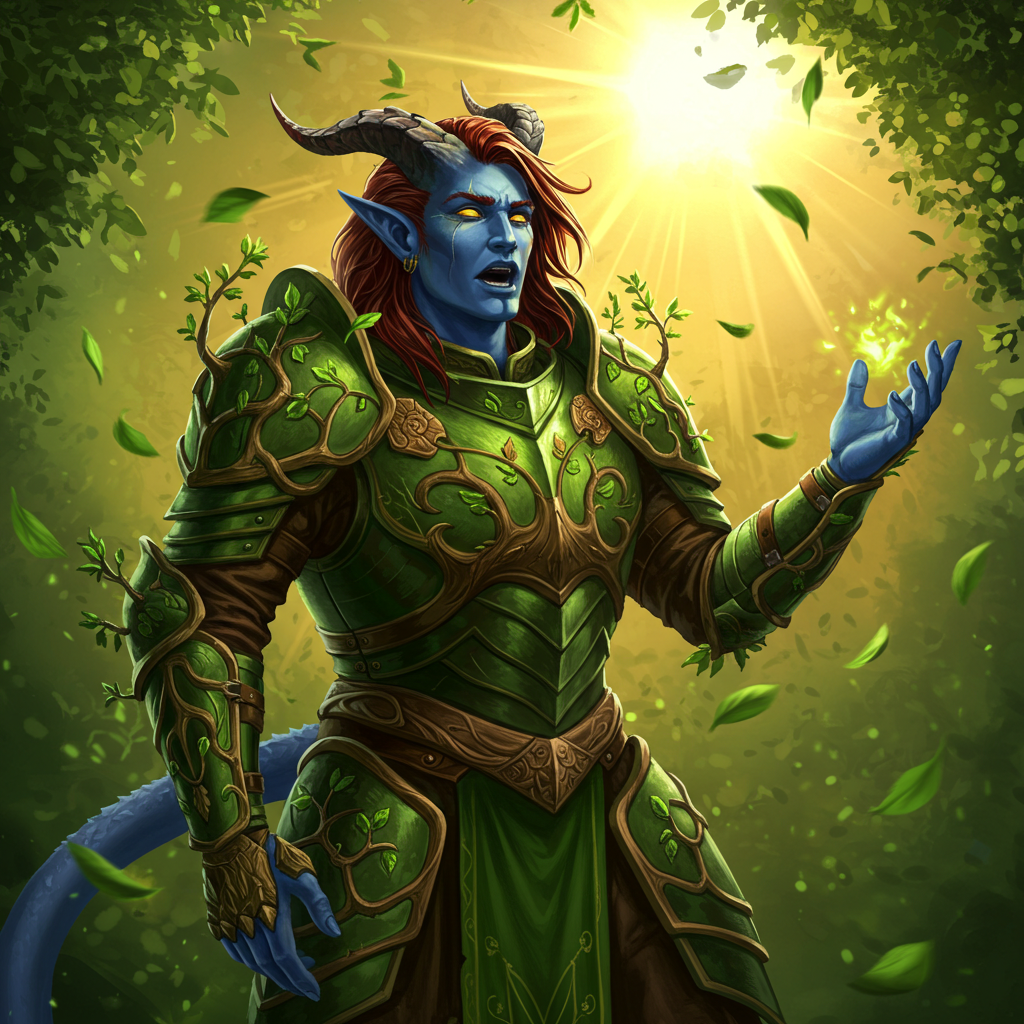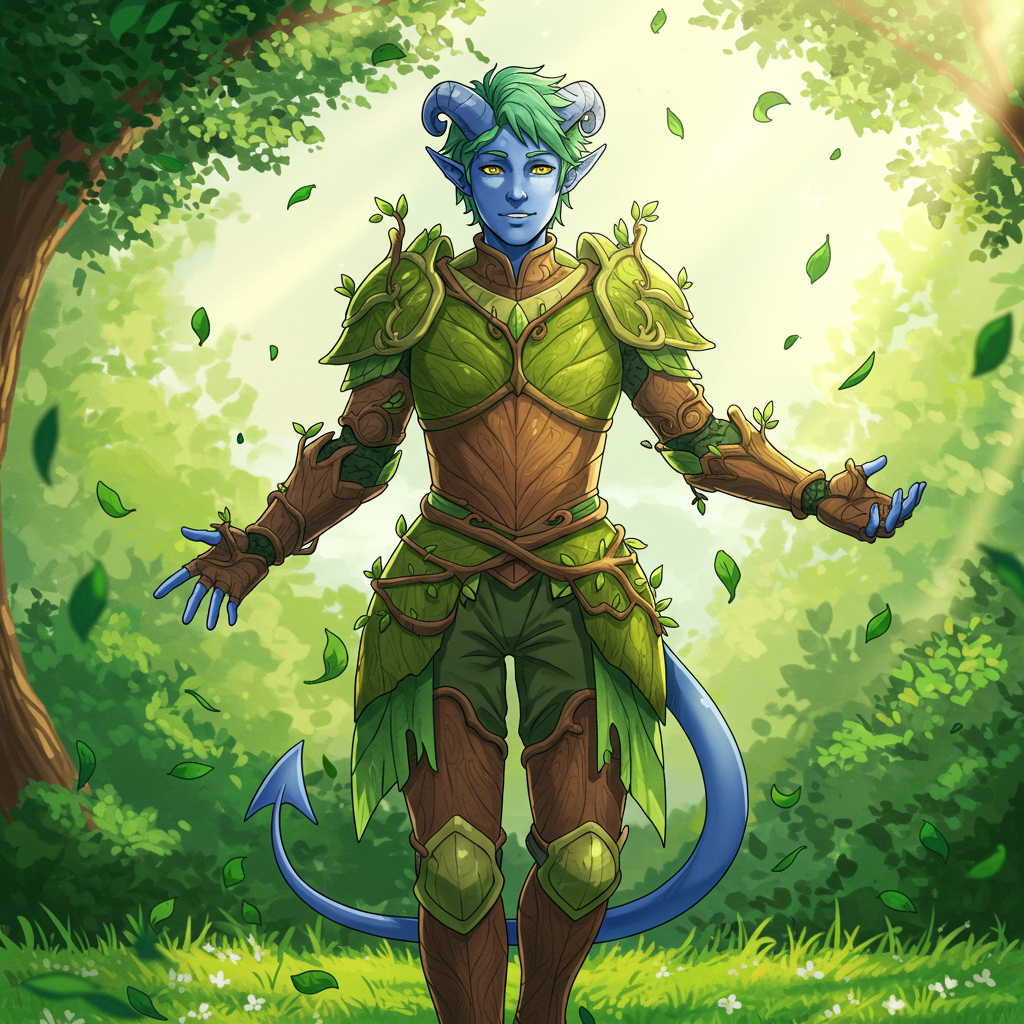The sun was high in the sky, it was noon and its bright light shone through the ancient canopy. Elara, a paladin, came upon a few children huddled together visibly showing terror and despair. She asked them what happened and they told her about how their village was raided by goblins, stealing what little food and toys they had – their only sources of joy left in the world. Elara was not just any paladin, she swore an oath to serve the light and protect the joy in the word – an Oath of the Ancients. Her verdant ivy-themed armor rustled softly as she knelt. She decided addressing the victims of the goblins was more important than pursuing the goblins immediately. She pulled out a small, intricately carved wooden bird from her pouch and she began to tell a tale of talking animals and mischievous sprints full of whimsy and wonder. She smiled as she saw the color return to the childrens’ faces, which were pale with fear and sadness a while ago. Their eyes betrayed a sense of wonder as they listened and the canopy was interspersed with the sounds of their giggles as Elara’s tales took some humorous turns. Only after ensuring their joy was rekindled and their spirits lifted did she set off to hunt the goblins and bring them to justice. Justice for the vulnerable community they plundered from.
As she was following the trail of the goblins, Elara stumbled upon a hidden glade where a single, luminous flower bloomed amidst a path of withered weeds. She paused, despite the urgency of her hunt. Her hand instinctively reached out to gently brush the petal of the luminous flower.. The flower pulsed with a soft, inner light – a testament to the resilience of life. She felt tranquility and renewed vigor as she contemplated on what the flower represented. The beauty of this small bloom reminded her of the joy she fought to protect, reinforcing her resolve. She finally reached the simple and crude camp of the raiders. Their leader, a hulking brute, sneered and threatened. He towered over her and mocked, describing graphically what he and his underlings would do to her if she lost. Elara refused to back down, determination blazing behind her sharp gaze. Her massive opponent’s words bouncing off harmlessly off of her steel resolve to uphold her paladin oath. She has conviction. She does not waver. She wants to end this. Her voice booms as she commands them to release their stolen goods and cease their terror. Her tone was stern and radiating authority, but at the same time softened around the edges with an unexplained gentleness. She was hoping her presence and proclamation would be enough to make the goblins back down, but it was not. That’s what her steel weapons and her magic are for, she supposes.

Mechanically, paladins from D&D have consistently been powerhouse characters because of their smiting ability. However, changes in the 2024 Dungeons and Dragons update made them slightly more balanced in this regard. They are still strong, but now have a lower ceiling of becoming overpowered in raw smiting ability compared to when the 2014 rules first came out. This was balanced out by tweaking their other aspects to make them more flexible – such as improving their spellcasting options.
With that said, let us dive more deeply into one of the possible paths a paladin may take once they swear a binding oath – The Oath of the Ancients.
From the Player’s Handbook: The Oath of the Ancients is as old as the race of elves and the rituals of the druids. Sometimes called fey knights, green knights, or horned knights, paladins who swear this oath cast their lot with the side of the light in the cosmic struggle against darkness because they love the beautiful and life-giving things of the world, not necessarily because they believe in principles of honor, courage, and justice. They adorn their armor and clothing with images of growing things – leaves, antlers, or flowers-to reflect their commitment to preserving life and light in the world.

“Love for the beautiful and life-giving things in the world.”
This profound love is the core motivation for paladins who swear the Oath of the Ancients, driving them to fight for and aid others. The sun, a vital source of this beauty and life, nourishes the world by empowering its greenery through photosynthesis. Beyond direct sustenance, it provides warmth and light, essential for countless creatures. The plants it nurtures feed herbivores, who in turn sustain carnivores, creating a vibrant cycle of life. This encompasses fields of grass, flowing rivers, teeming fish, and the bounty of fruits, all bathed in sunshine – light and life for the body. But the oath also embraces the light and life that nourishes the mind: the joy of music, the release of laughter, the connection of dancing, the comfort of friendship, the strength of bonding, the security of family, and the support of community. Even the breathtaking vista from a mountaintop embodies this love. Ultimately, the Oath of the Ancients champions both the tangible and intangible beauty and vitality of the world.
Tenets of Oath of Ancients Paladin
This specific paladin Oath emphasizes the principles of good above any concerns of law or chaos. In this case, “good” means allowing the light and life in the world to survive and thrive. To quote verbatim, it has 4 central principles:
Kindle the Light. Through your acts of mercy, kindness, and forgiveness, kindle the light of hope in the world, beating back despair.
Shelter the Light. Where there is good, beauty, love, and laughter in the world, stand against the wickedness that would swallow it. Where life flourishes, stand against the forces that would render it barren.
Preserve Your Own Light. Delight in song and laughter, in beauty and art. If you allow the light to die in your own heart, you can’t preserve it in the world.
Be the Light. Be a glorious beacon for all who live in despair. Let the light of your joy and courage shine forth in all your deeds.
The image of a knight standing sentinel over a woodland forest, fiercely defending their delicate ecosystem, deeply resonates with me. I’m also particularly drawn to their selective neutrality, wherein they reserve their power for use against those who engage in unsustainable exploitation of nature or sow darkness and despair across the land. Moreover, the understanding that the ancients of this oath are likely nature spirits and fey establishes a captivating thematic link to the Archfey Warlock, a subclass that holds a strong fascination for me.
Let’s more closely examine the tenets and how each one could relate to the solarpunk or hopepunk movements:
Kindle the Light. Through your acts of mercy, kindness, and forgiveness, kindle the light of hope in the world, beating back despair.
This tenet emphasizes the value of pacifism. Although paradoxically the last three words used implies violence, it is overtly reserved only for those who would bring despair to the world. Hopepunk emphasizes the values espoused here: mercy, kindness, forgiveness, and of course – hope.
What everyday acts of mercy can we practice? One fundamental act is respect for all life, which can manifest in refraining from animal cruelty. This might even extend to avoiding the killing of insects, choosing instead to gently guide them away, even if it’s less convenient than simply swatting them. This approach aligns with many Indigenous traditions that teach us animals are our kin and that all of nature is sacred, deserving of our respect.
Consider the power of kindness. What simple, everyday acts can we weave into our lives? We might offer a genuine smile to a friend who seems downcast, give a comforting hug freely, share food with someone, or even extend that generosity to those experiencing homelessness by providing food, clothing, and blankets. Or we could simply take the time to talk to someone when we sense their anxiety. Even just being a familiar and reassuring presence in a crowd can be an act of kindness. These seemingly small gestures can have a far greater impact on someone’s life than we might ever realize.
What about forgiveness? The Bible teaches us to turn the other cheek when someone wrongs us. The full quote is “But I tell you, do not resist an evil person. If anyone slaps you on the right cheek, turn to them the other cheek also.” To some people, this may be the most difficult to uphold. It’s very tempting to preserve our ego and never let our image be tarnished in others’ eyes, yet there is the Buddhist saying “Holding on to anger is like grasping a hot coal with the intent of throwing it at someone else; you are the one who gets burned.” Even in Judaism letting go of thoughts of revenge is considered a divine command, a mitzvah: “You shall not hate your brother in your heart. You shall surely rebuke your fellow, but you shall not bear a sin on his account. You shall neither take revenge from nor bear a grudge against the members of your people; you shall love your neighbor as yourself. I am the Lord.”
Shelter the Light. Where there is good, beauty, love, and laughter in the world, stand against the wickedness that would swallow it. Where life flourishes, stand against the forces that would render it barren.
This tenet makes us look at how we can keep the light safe. What ways can you imagine? Preventing deforestation is one thing. Unchecked exploitation of natural resources is one of the wicked things which could render a place where life flourishes barren. Conservation of marine life is another. The balance of the sea’s ecosystem is paramount for the preservation of the food chain since it will allow the sustainability of multiple sources of sustenance for humankind. To look at an everyday micro-example, then bullying can be something interpreted as sucking the joy and life away from someone that the bully perceives as weaker than themselves.
Essentially, one must become a steadfast guardian of all that is bright and precious in the world. It demands a vigilant stance against the creeping shadows of wickedness that seek to extinguish joy, mar beauty, and silence love and laughter. Where these vibrant sparks of existence flicker and burn, the paladin of the Oath of the Ancients stands as a bulwark, an unwavering shield against those who would consume them. Furthermore, this tenet calls for the defense of life itself in its myriad forms. Wherever life flourishes, be it in a single bloom or an entire ecosystem, the paladin must confront and repel the forces that would bring desolation and barrenness, ensuring that the flame of vitality continues to burn strong and untamed.
Preserve Your Own Light. Delight in song and laughter, in beauty and art. If you allow the light to die in your own heart, you can’t preserve it in the world.
This tenet makes us examine how to keep the light shining bright within us, even during the toughest of times. It reminds us to consistently take the time to appreciate the good things in life. Mindfulness and gratitude practice could be ways to “strengthen” this so to speak. What other ways can you think of in order to keep yourself safe?
To “Preserve Your Own Light” is not an act of selfishness, but a vital component of the Oath of the Ancients. It is a call to actively seek joy and find solace in the wonders of existence. Delight in the melody of song, the infectious release of laughter, the captivating allure of beauty, and the expressive power of art. These are not mere indulgences, but essential fuel for the soul. For if a paladin allows the light within their own heart to dwindle and fade, how can they effectively champion and protect that same light in the wider world? The ability to recognize, nurture, and defend goodness stems from an inner wellspring of hope and joy; to neglect this inner flame is to diminish one’s capacity to illuminate the darkness around them.
Be the Light. Be a glorious beacon for all who live in despair. Let the light of your joy and courage shine forth in all your deeds.
This tenet encourages us to help light the way for others and show that there is a way out of the cold, dark place they found themselves in. We can do this by practicing what we preach and upholding the values we learned. What actions can we take? One way could be volunteer work. Orphanages, Non-government Organizations, Animal Welfare, there are several places with volunteer work opportunities where we can influence the lives of others for the better.
To “Be the Light” is to embody the very essence of hope and courage for those lost in the shadows of despair. It is a call to action, urging the paladin to become a glorious beacon, radiating warmth and guidance to all who dwell in darkness. This is not a passive role; rather, it demands that the light of one’s own joy and unwavering courage shine forth brightly in every deed, every word, and every interaction. By living with such radiant conviction, the paladin inspires others, offering a tangible example of the good that can prevail and illuminating a path forward for those who have lost their way.
As a mental exercise, what could be some actions we can take right now in the real world to uphold the tenets? Ones that go beyond the everyday actions I gave above, that is.

In summary, swearing to the Oath of the Ancients guides paladins to fully embrace the light and joy of the world. The four core tenets take care of this. Kindle the Light by spreading joy through small gestures and defending places of natural beauty. Shelter the Light by protecting the innocent, standing against cruelty, and preserving life within a community or ecosystem. Preserve your own Light by actively replenishing your own reserves of joy, ensuring you take care of your own well-being to maintain your own inner hope, and that you appreciate art and beauty. Lastly, Be the Light by acting in courage and compassion, offering guidance and inspiration to those suffering in despair and consistently acting as a positive force in the world.
What do you think? Do you believe that incorporating these virtues into your own life is too much? Too tall of an order? Personally, I think rising up to the challenge of being the light in others’ lives is a worthy endeavor to include in my own life goals.
I hope that in reading this article, some of the aspects of this paladin subclass resonates with you and you rise to the challenge too.

Note: If you’re wondering why I’m using a blue tiefling for the images, it’s because it’s been one of the commonly advised races to min-max the class for Baldur’s Gate 3. A blue tiefling also coincidentally calls to mind a certain comic book character which I believe embodies this Oath’s tenets to some degree – Nightcrawler. Specifically, the Krakoan Era Nightcrawler. But in order to not make this article too lengthy, that will be a topic for another time so stay tuned.
